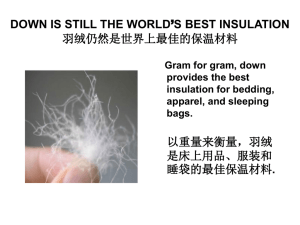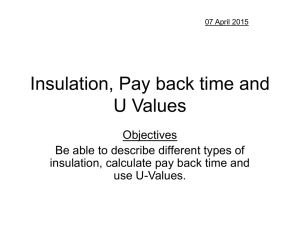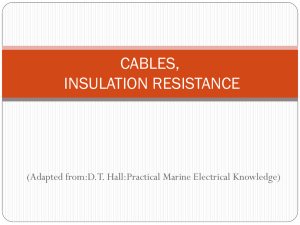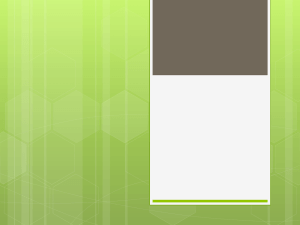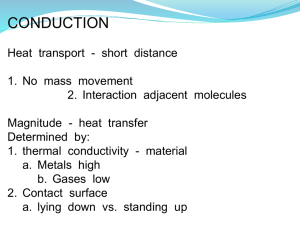Cavity Wall Insulation
advertisement
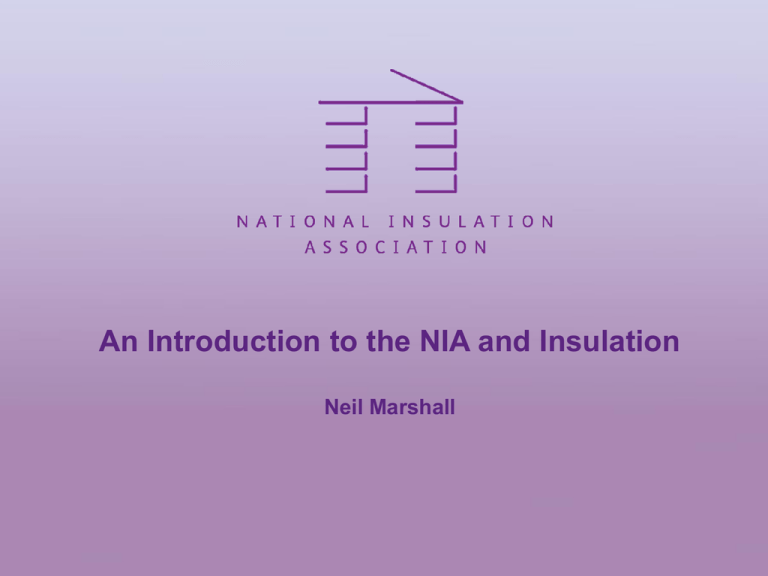
An Introduction to the NIA and Insulation Neil Marshall Who we are • Represent manufacturers and installers – Wall Insulation - CWI, EWI, IWI, Hybrid – Loft/Roof Insulation – Draught Proofing/Air Leakage • 170 members - GB and NI • Full service TA – – – – Promote the benefits of insulation Range of membership services Industry representation Work in partnership with like minded organisations • Maintain Standards – Membership criteria, – Code of Professional Practice Where does the heat go? • 45% of heat lost through uninsulated solid walls • 33% of heat lost through uninsulated cavity walls • 25% of heat lost through the roof/loft space • 20% of heat lost windows and doors The Benefits of Insulation • Solid Wall Insulation • Save around £375 a year on heating bills • Reduce (CO 2) emissions by around 2 tonnes each year • Cavity Wall Insulation • Save around £110 a year on heating bills • Pay back in just 2 years • Reduce (CO 2) emissions by around 560kg each year • Loft insulation • Save around £145 a year on heating bills • Pay back in under 2 years • Reduce (CO 2) emissions by around 800kg each year The Opportunity Over half the existing housing stock in the UK has inadequate levels of insulation! • 7m properties have solid walls that are not insulated • 8m properties with uninsulated cavity walls • Around 13m lofts with inadequate insulation • Most people have some loft insulation but it is not sufficient – to comply with modern standards it should be 270mm deep + 4.5m micro/SME businesses Market Drivers • Carbon Emissions Reduction Target - 2012 • Community Energy Saving Programme - 2012 • Energy Company Obligation - 2013 • Green Deal – October 2012 • Residential and commercial buildings Cavity Wall Insulation • Permanent, maintenance free home improvement, lasting the life of the building • Most homes built from 1920 onwards have cavity walls • Cavity wall insulation fills the cavity between the inner and outer walls - reducing the amount of heat that is lost Cavity Wall Insulation • Small holes are drilled into the outside walls and CWI material is blown into the cavity • Holes in the brickwork are filled post insulation • 3 types of material are used • mineral wool/polystyrene beads/foam • CIGA (Cavity Insulation Guarantee Agency) issue an independent 25 year guarantee covering defects in materials and workmanship Loft Insulation • Loft insulation reduces the amount of heat escaping through the roof by providing a layer of material with air pockets that trap the heat • The recommended depth of loft insulation is 270mm (mineral wool) • There are three types of insulation used: • mineral wool quilt/blown mineral wool/cellulose and polystyrene boards Loft Insulation • Mineral wool quilt is the most common material used • Quilts are laid down between the joists then another layer of insulation is `cross-laid' to cover the joists • Insulation makes the house warmer but the roof colder so it is important to insulate tanks and pipes in the loft space Internal Wall Insulation Solutions Built up insulated framework Solid Wall Studs Insulation Vapour control layer / Plasterboard Internal Wall Insulation Solutions Laminated insulated plasterboard Solid Wall Bonded insulation Plasterboard Internal Wall Insulation Solutions Thermal insulation on a roll Internal Wall Insulation Solutions Multifoils / Aerogels Internal Wall Insulation • Suitable for installation where the external wall appearance cannot be changed (planning restrictions) • Can be utilised where there is insufficient external clearance to install external wall insulation • It can be installed on a room-by-room, single façade or whole house basis, as part of a full refurbishment plan External Wall Insulation Adhesive Insulation Insulation Fixing Render with Reinforcing Mesh Decorative Render Finish External Wall Insulation • Very high levels of insulation possible. • No internal disruption. • Effective for new and existing buildings. • Building fabric is protected from the weather (extends buildings life). • Overcomes cold bridging, condensation and dampness. • Enables building appearance to be improved / modified. Hybrid Approach • Front appearance retained using IWI • Side/Rear and any extension can benefit from EWI • The same techniques are adopted for standard IWI/EWI Support Available • Information – www.nationalinsualtionassociation.org.uk – Literature • Communication – NIA Local Forums – E-briefs, newsletter • Access to members – Postcode Locator • Issue expressions of interest/tenders • Referrals/Lead Generation Schemes? For more information: www.nationalinsulationassociation.org.uk Tel: 01525 383313



